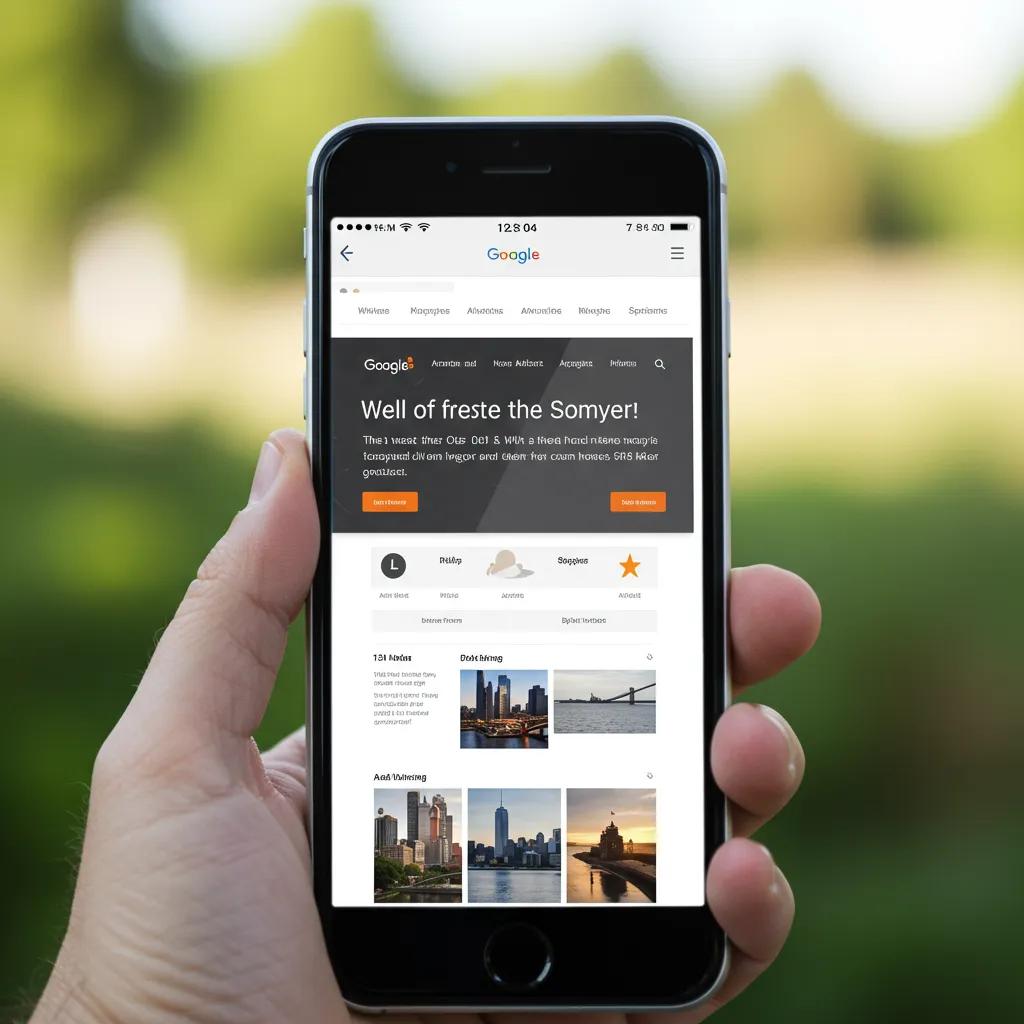Responsive Web Design Principles for Modern Websites: Best Practices and Business Benefits
Responsive web design ensures a single website adapts fluidly to different screen sizes, input modes, and connection speeds, delivering consistent user experience across phones, tablets, laptops, and desktops. This article explains the core principles — fluid grids, flexible images, and CSS media queries — and shows how mobile-first thinking and semantic HTML improve performance, accessibility, and search visibility in 2025. Many small and medium businesses struggle with lost mobile leads and slow pages; applying responsive design principles addresses those pain points by reducing friction, improving Core Web Vitals, and protecting SEO. Readers will learn practical implementation patterns, testing and performance tactics, and measurable business outcomes that tie design work to lead generation. The guide covers core principles, mobile-first effects on SEO and performance, specific business benefits (with a compact EAV table), performance optimization techniques (with a recommended techniques table), and how The Digital Marketing People Inc. applies these principles for SMB growth.
What Are the Core Principles of Responsive Web Design?
Responsive web design centers on three interlocking principles that let layouts and content adapt to user contexts automatically. Fluid grids use relative units so structural elements resize proportionally, flexible images ensure media scales without overflow, and CSS media queries apply conditional styling based on viewport characteristics. These mechanisms work together to improve usability, reduce maintenance overhead, and keep content parity across devices, which in turn supports consistent indexing and better user engagement. Understanding these foundations prepares teams to implement device-agnostic interfaces that drive conversions and lower bounce rates.
How Do Fluid Grid Layouts Enable Dynamic Website Design?

A fluid grid replaces fixed pixel columns with proportional units (percent, fr, rem), letting layouts resize smoothly as viewports change. CSS Grid and Flexbox implement these proportional relationships, enabling components to reflow, reorder, and align without separate templates for each device. This approach reduces duplicated CSS and maintenance time while preserving visual hierarchy and brand consistency across breakpoints. Consistent layout behavior across viewports directly supports predictable user journeys, improving conversion potential and reducing redesign cycles for feature updates.
Why Are Flexible Images Essential for Responsive Websites?
Flexible images avoid oversized assets on small screens and ensure the browser requests appropriately scaled files for each layout, reducing bandwidth and improving LCP. Techniques like max-width: 100%, the img srcset/sizes attributes, and the picture element with art-directed sources let developers serve different crops or formats per breakpoint. Combining responsive images with modern formats (WebP, AVIF) and proper caching decreases payload and speeds perceived load time. Faster, correctly proportioned media reduces visual shift and creates a smoother UX that encourages users to complete forms or take action.
How Do CSS Media Queries Create Adaptive User Experiences?
CSS media queries apply conditional rules based on viewport width, resolution, pointer type, and reduced-motion preferences, enabling adaptive styling that reflects device capabilities. Best practice is content-first breakpoints: set breakpoints where layout needs to change rather than targeting specific device models, which future-proofs designs against new screen sizes. Media queries, paired with feature and container queries, support modular, component-driven design systems that adapt without global overrides. Thoughtful breakpoint strategy improves accessibility and ensures interactive elements remain usable on touch and non-pointer devices.
How Does Mobile-First Design Improve Website Performance and SEO?
Mobile-first design starts by optimizing for constrained screens and connections, which drives leaner markup, prioritized content, and better Core Web Vitals—factors search engines increasingly use to rank pages. Designing for mobile forces teams to reduce unnecessary scripts, inline critical CSS, and defer nonessential resources, lowering time-to-interactive and LCP. Content parity and structured, semantic HTML ensure search engines index the whole experience, while mobile usability metrics and speed signals help rankings. These combined effects boost discoverability and the likelihood that organic mobile visitors convert into leads.
What Is the Mobile-First Design Strategy and Why Is It Important?
Mobile-first strategy means designing and prototyping for mobile constraints before progressively enhancing for larger screens, ensuring the most important content and actions are prioritized. Given that a growing majority of sessions originate on mobile devices and search engines use mobile-first indexing, this approach aligns product design with how users actually browse. Practically, mobile-first reduces cognitive load, optimizes touch targets, and removes decorative overhead that harms performance. Prioritizing the mobile baseline yields cleaner HTML and fewer surprises when scaling up to tablet and desktop.
How Does Mobile-First Design Enhance SEO Rankings?

Mobile-first design improves SEO by delivering fast, usable pages that satisfy Core Web Vitals and mobile usability checks, both of which influence ranking algorithms. Ensuring content parity—same primary content on mobile and desktop—prevents indexation gaps and supports consistent metadata and structured data exposure. Optimized assets, compressed images, and lazy loading reduce server load and speed indexability, while semantic HTML helps search engines and AI parsers extract key entities and relationships. These mechanisms translate into higher organic visibility and better-qualified traffic.
What Are the Best Practices for Implementing Mobile-First Responsive Design?
A concise checklist guides effective mobile-first implementation and testing across breakpoints and devices. Include viewport meta tag with width=device-width and initial-scale=1, prioritize critical content and calls to action, use touch-friendly targets (minimum 44px), and lazy-load offscreen images and third-party scripts. Test performance with Core Web Vitals tools and verify structured data and accessibility with automated and manual audits. Iterative A/B testing of mobile flows helps quantify conversion uplift and refines the balance between speed and features.
What Are the Key Benefits of Responsive Web Design for Modern Businesses?
Responsive design converts technical improvements into measurable business outcomes: higher mobile conversions, better retention through improved UX, and stronger SEO performance that drives qualified leads. By reducing friction and improving load times, organizations typically see higher form completion rates and lower bounce rates, which support lead generation goals. Accessibility and semantic HTML broaden audience reach and improve reputation, while consistent experiences across touchpoints enhance brand credibility. The table below maps common benefits to the metric they most directly influence and the expected business effect.
How Does Responsive Design Increase Conversion Rates and Lead Generation?
Responsive design reduces friction points—misaligned inputs, tiny buttons, or slow forms—that cause abandonment on mobile, thereby improving conversion flow. Faster LCP and lower interaction delays increase user trust and decrease drop-off during checkout or contact forms. Consistent branding and accessible navigation reduce cognitive friction and support repeat visits and referrals. Measurable uplifts in mobile conversions often follow targeted optimizations to images, forms, and critical CSS.
Why Is Responsive Design Critical for User Experience and Customer Retention?
A usable, fast, and accessible site encourages longer sessions and repeat visits, which strengthen customer retention and lifetime value. Usability issues are a primary source of negative feedback; responsive design eliminates common mobile pain points, such as horizontal scrolling and inaccessible navigation. Improving perceived performance and interaction reliability fosters positive perception and a higher propensity to recommend the brand. Long-term retention supports referral flows, lowering acquisition costs and amplifying ROI from digital channels.
How Does Responsive Design Support SEO and Mobile-First Indexing?
Responsive sites present the same content and structured data across devices, ensuring mobile-first indexing sees the entire page and the metadata engines use to rank content. Core Web Vitals improvements driven by responsive techniques (image optimization, critical CSS) are correlated with better search placement. Semantic HTML elements and proper ARIA usage help search engines and assistive tech interpret content structure and entities. Together, these practices increase discoverability and ensure content remains accessible to evolving AI-driven search experiences.
How Can You Optimize Website Performance with Responsive Design Techniques?
Performance optimization in responsive sites focuses on delivering the right resources at the right time, minimizing render-blocking assets, and tailoring media to device capabilities. Key tactics include responsive images with srcset and sizes, critical-path CSS inlining, deferring nonessential JavaScript, and leveraging lazy loading for offscreen media. These techniques reduce payload, improve Core Web Vitals, and enhance perceived speed for users on limited bandwidth. The table below pairs responsive techniques with the performance attribute they improve and the recommended approach.
What Role Does Page Load Speed Play in Responsive Web Design?
Page load speed directly affects user behavior: slow pages increase abandonment and lower conversion rates, while fast pages improve engagement and retention. Core Web Vitals (LCP, CLS, INP) are practical metrics for measuring this impact and guiding optimizations. Quick wins include optimizing images, minimizing third-party scripts, and reducing payload sizes to improve time-to-first-byte and rendering performance. Prioritizing speed in a responsive workflow ensures designs remain performant across variable mobile networks and device classes.
This emphasis on speed is crucial to a positive user experience, as experts in the field highlight.
Optimizing Responsive Websites for Performance and User Experience
Whether you have already built your site or you are about to embark on building a responsive project, you need to ensure you take time to optimize your site for performance. Performance is not a nice-to-have feature, but rather a necessity of the multidevice modern web, as it is a key part of the user experience. Web site performance, however, is a very large subject area. In fact, there are books dedicated to only parts of it, so I am going to focus in this chapter on areas of web site performance and site optimization that can make the biggest difference to a responsive site.
Optimizing your responsive site, 2014
How Do Responsive Images and Media Queries Improve Site Speed?
Serving appropriately sized images via srcset and the picture element prevents oversized downloads on mobile, and media queries can conditionally load heavier assets only on capable viewports. Pairing these with modern formats (AVIF/WebP) and adaptive compression reduces bandwidth while preserving visual quality. Conditional resource loading via media attributes or intersection observers defers offscreen assets until needed. These steps reduce initial payload sizes, improving LCP and perceived performance for mobile users.
Why Is Semantic HTML Important for Responsive and Accessible Websites?
Semantic HTML elements—header, main, nav, section, and article—provide a clear structure that helps browsers, search engines, and assistive technologies interpret content hierarchy. Using semantic tags and descriptive alt text improves accessibility compliance and enables better entity extraction for search and AI-driven summaries. Semantic markup supports progressive enhancement, letting devices render meaningful content even when advanced CSS or JS is unavailable. Clear semantics also simplify testing and automated audits, accelerating remediation and improving discoverability.
How Do The Digital Marketing People Implement Responsive Web Design for Business Growth?
The Digital Marketing People Inc., based in Oshawa, Canada, focuses on website design and optimization for small to medium-sized businesses and local or national brands in Canada and the US. Their approach applies mobile-first principles, performance optimizations, and CRO tactics to convert mobile traffic into leads, using metrics-driven roadmaps that prioritize Core Web Vitals and conversion improvements. Deliverables emphasize measurable outcomes—improved mobile traffic engagement, reduced bounce rate, and higher form completion—while offering clear next steps such as audits and scoped proposals for SMBs seeking faster lead generation.
What Responsive Design Services Are Offered for SMBs in Canada and the US?
The Digital Marketing People Inc. offers website design and optimization services tailored to SMBs, combining mobile-first design, performance engineering, and CRO to improve lead generation. Service packages typically include responsive templates or custom builds, asset optimization, and on-site SEO practices that support discoverability and conversion. The agency positions itself as a growth partner focused on visibility, credibility, and measurable conversions across digital touchpoints. Businesses receive prioritized roadmaps that match technical improvements to marketing outcomes.
How Do Responsive Web Design Principles Translate Into Measurable Business Results?
Principles like image optimization map directly to LCP improvements, fluid grids reduce layout regressions that harm form interactions, and media query strategies ensure content parity for mobile-first indexing—each tied to KPIs such as traffic quality, bounce rate, and conversion rate. Monitoring uses tools like analytics and Core Web Vitals reporting to quantify uplift and refine priorities. Clients can expect clearer attribution between technical fixes and lead generation metrics after iterative testing and performance remediation.
How Can You Get Started with Responsive Web Design Services?
To begin, request an audit that assesses mobile usability, Core Web Vitals, and conversion funnels to identify high-impact changes and a phased roadmap. Typical next steps include prioritizing quick wins (image optimization, critical CSS) and scheduling scoped sprints for design and development work. This approach delivers early performance improvements and measurable uplifts in lead capture as larger UX and content projects roll out. Interested SMBs can contact The Digital Marketing People Inc. to request an audit and a tailored proposal to align responsive design with lead-generation goals.
Frequently Asked Questions
What are the common challenges businesses face when implementing responsive web design?
Businesses often encounter several challenges when adopting responsive web design. These include ensuring compatibility across various devices and browsers, managing the complexity of fluid layouts, and optimizing images for different screen sizes. Additionally, teams may struggle to maintain performance when integrating responsive features, as poorly optimized sites can lead to slow load times. Training staff on best practices and keeping up with evolving web standards can also pose difficulties, making it essential for businesses to invest in ongoing education and resources.
How can I test the effectiveness of my responsive web design?
To test the effectiveness of your responsive web design, use tools such as Google’s Mobile-Friendly Test and PageSpeed Insights. These tools assess how well your site performs on mobile devices, providing insights into load times, usability, and Core Web Vitals. Additionally, conduct user testing with real users on various devices to gather feedback on navigation and overall experience. A/B testing different layouts can also help identify which designs yield higher engagement and conversion rates, enabling data-driven improvements.
What role does accessibility play in responsive web design?
Accessibility is a crucial aspect of responsive web design, ensuring that all users, including those with disabilities, can navigate and interact with your site effectively. Implementing semantic HTML, providing alternative text for images, and ensuring keyboard navigability are essential practices. Responsive design should also consider color contrast and font size to enhance readability. By prioritizing accessibility, businesses not only comply with legal standards but also expand their audience reach, improving user experience and fostering inclusivity.
How does responsive design impact website maintenance?
Responsive design can significantly reduce website maintenance by allowing a single codebase to serve all devices, rather than maintaining separate mobile and desktop sites. This unified approach simplifies updates, as changes made to the design or content are automatically reflected across all platforms. However, it requires careful planning and testing to ensure that all elements function correctly on various screen sizes. Regular audits and performance checks remain necessary to maintain an optimal user experience and address emerging issues.
What are the best tools for creating responsive web designs?
Several tools can aid in creating responsive web designs, including frameworks like Bootstrap and Foundation, which provide pre-built responsive components. CSS Grid and Flexbox are essential for creating fluid layouts. Design tools like Adobe XD and Figma allow for prototyping and testing responsive designs before development. Additionally, browser developer tools can help simulate different devices and screen sizes, enabling real-time adjustments. Utilizing these tools can streamline the design process and enhance collaboration among team members.
How can I ensure my responsive website is optimized for SEO?
To optimize your responsive website for SEO, focus on maintaining content parity across devices, ensuring that the same content is accessible on both mobile and desktop versions. Use semantic HTML to enhance search engine understanding of your content structure. Optimize images for faster loading times and implement proper meta tags for mobile usability. Regularly monitor Core Web Vitals and make adjustments based on performance metrics. Additionally, ensure your site is correctly indexed by submitting a sitemap to search engines.
What future trends should I consider in responsive web design?
Future trends in responsive web design include the increasing use of artificial intelligence for personalized user experiences and the rise of voice search, which necessitates optimizing content for voice queries. Additionally, adopting dark mode and enhanced animations can improve user engagement. As 5G technology becomes more widespread, designers will need to consider how faster connections impact user expectations for speed and interactivity. Staying informed about these trends will help businesses remain competitive and meet evolving user needs.
Conclusion
Implementing responsive web design principles significantly enhances user experience, leading to higher mobile conversions and improved SEO performance. By prioritizing mobile-first strategies, businesses can reduce bounce rates and foster customer retention through accessible and engaging interfaces. The measurable benefits of optimized layouts and fast-loading pages translate directly into increased lead generation and brand credibility. Start your journey towards a more responsive and effective website by contacting The Digital Marketing People Inc. today.













Leave A Comment